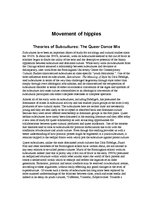-
Movement of Hippies
Subcultures have been an important object of study for sociology and cultural studies since the 1920's. In about the 1980's, however, work on subcultures seemed to fall out of favor as scholars began to doubt the utility of the term and the descriptive potential of the binary opposition between subculture and dominant culture. While early work on subcultures from the Chicago school assumed a relationship between subcultures and deviance or delinquency, later work from the Birmingham University Center for Contemporary Cultural Studies characterized subcultures as class-specific "youth formations.". One of the most influential texts on subcultures, Subcultures: The Meaning of Style by Dick Hebdige, read subcultures in terms of the way they challenged hegemony through style rather than simply through overt ideological articulations; and he characterized the recuperation of subcultural disorder in terms of either an economic conversion of the signs and symbols of the subculture into mass culture commodities or an ideological conversion of the subcultural participant into either complete otherness or complete spectacle.
Almost all of the early work on subcultures, including Hebdige's, has presumed the dominance of males in subcultural activity and has studied youth groups as the most lively producers of new cultural styles. The subcultures here are neither male nor necessarily young and they are less likely to be co-opted or absorbed back into dominant culture because they were never offered membership in dominant groups in the first place. Queer lesbian subcultures have rarely been discussed in the existing literature and they offer today a new area of study for queer scholarship as well as exciting opportunities for collaborations between queer cultural producers and queer academics. One of the reasons that theorists tend to look to subcultures for political mobilization has to do with the conflation of subculture and youth culture. Even though this reading provides us with a better understanding of how political protest might be registered in a youth subculture, it remains trapped in the oedipal frame work which pits the subculture against parent culture.
Queer subcultures, unlike the male dominated youth cultures that Dick Hebdige, Stuart Hall and other members of the Birmingham school have written about, are not located in any easy relation to so-called parent cultures: Much of the Birmingham school work on subcultures indeed (and this is partly why it fell out of favor in the early 1990's) presumed an oedipalized structure within which rebel youths reject the world of their parents and create a netherworld within which to reshape and reform the legacies of an older generation. Economic, political and social conflicts may be resolved in subcultural arenas, according to these arguments, without really effecting any grand changes at the level of superstructure. Of course such a theory of subcultures has long since been replaced by more nuanced understandings of the relations between class, youth and mass media and indeed in an essay on youth cultures, "Different, Youthful, Subjectivities: Towards a Cultural Sociology of Youth," Angela McRobbie comments: "There is certainly no longer a case to be made for the traditional argument that youth culture is produced somehow in conditions of working-class purity, and that such expressions are authentic and in the first instance at least uncontaminated by an avaricious commercial culture."
…
Hipiju izcelshanaas, to kustiiba Eiropaa,divu cilshu apraksts.







